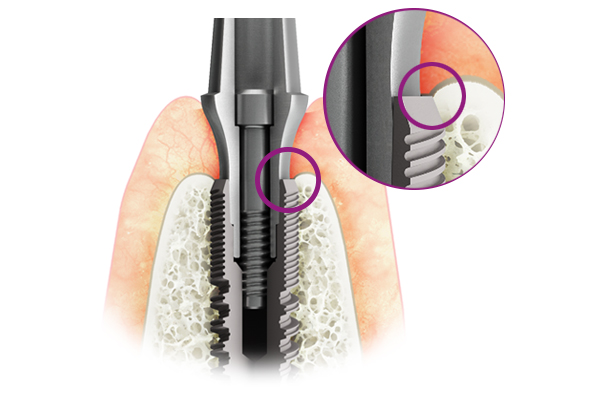Platform Switching Implant
Platform switching is defined as using prosthetic abutments whose diameter at the point which they emerge from the implant are smaller than then platform of the implant.
While in most dental implant systems on the market the abutment emerging diameter will be the same as the platform diameter. In the case of platform switching (also known as platform shifting) the emerging diameter of the abutment has been reduced to the approximate diameter of the implant connection.

Platform switching creates 2 main benefits:
- Distance of bone to the connection gap:
The abutments used with conventional implant types are generally flush with the implant shoulder in the contact zone. With many implant systems, this results in the formation of
microcracks between the implant and the abutment. Numerous studies have shown that bacterial contamination of the gap between the implant and the abutment adversely affects the stability of the periimplant tissue. If above-average axial forces are exerted on the implant, a pumping effect may ensue (depending on the positive internal/ external connection at the interface) that may then result in a flow of bacteria from the gap, provoking the formation of inflammatory connective tissue in the region of the implant neck. Ericsson et al coined the term distance-sleeve-associated infiltrated connective tissue to describe this phenomenon.
This bone loss may result in a reduction of the marginal bone level in both the vertical and the horizontal dimensions..
The platform switching concept requires that this microcrack be placed away from the implant shoulder and closer toward the axis in order to increase the distance of this microcrack from the bone. The preservation of the periimplant bone is particularly important in the esthetic zone and in areas with a limited bone supply. Here the objective is to avoid provoking an additional postprosthetic bone loss and to preserve the long-term stability of the bone and soft tissue alike. - Preserve the tissue around the implant:
The platform switching design results in a representative amount of supracrestal fibers ( Tarnow) and an additional advantage of preserving the underlying bone. (Gargiulio)The added gingival volume shows clinically to be beneficial for the volume of the future papilla and offer the practitioner more soft tissue to work with as well as create a more natural emergence profile for the reconstruction. Initial gingival tissue thickness at the crest may be considered as a significant influence on marginal bone stability around implants. (Linkevicius et al.)

